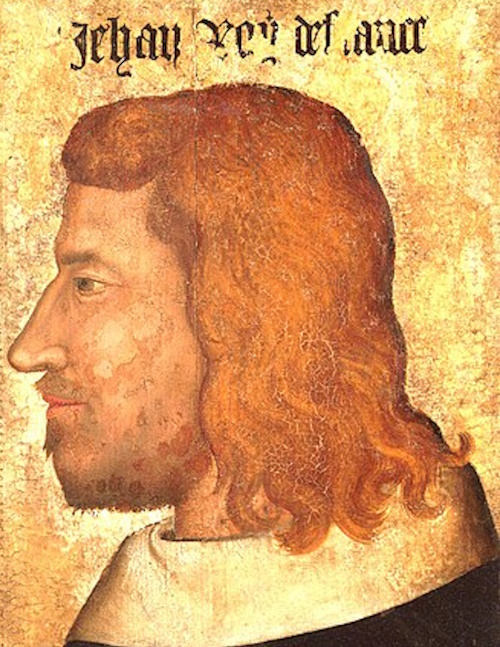
Almost five centuries after the reference to “Crudes silva” in a charter of King Alfred the Great two notable Royal visitors made a brief visit to hunt in what had by then become “the park of Cruddeswode” [parcum de Cruddeswode], a hunting park belonging to the Archbishop of Canterbury. The name evolved further into Curleswood Park, later becoming Curleswood Park Farm and then Park Farm. Most of the park area is now covered by the village of Aylesham and its adjoning industrial estate with the remainder soon to disappear under the ongoing “Aylesham Garden Village” developement.
At the Battle of Poitiers in 1356 King John II of France, known as John the Good, had been taken prisoner and subsequently held to ransom for the sum of three million crowns, roughly two to three times the gross revenues of the kingdom of France. The French king enjoyed a very comfortable imprisonment at various places in England, his account books for his time in captivity record that he had a personal retinue, or court, that included an astrologer and a court band and that he spent large amounts on horses, pets, and clothes.
King John remained captive until the drafting of the Treaty of Brétigny in May of 1360, which set out the terms of his release and led to the king leaving his final place of imprisonment in the Tower of London on 30th June, although the treaty was not actually ratified until October of that year. At the time of the French king’s imprisonment at the Tower of London the Constable of the Tower was Sir John de Beauchamp, who fought alongside the Black Prince at Poitiers and several other battles, and had a manor house a mile or so to the east of Cruddeswode at Esol, just off of Beauchamps Lane in what is now Easole Street in Nonington. As Constable of the Tower is very likely that Sir John would have been a member of the entourage escorting King John on his journey to Dover as in keeping with his royal status the French monarch would have expected to have high ranking officials in attendance on his journey.
From the Tower John II proceeded to the Palace of Eltham where Queen Philippa of England gave him “a great farewell entertainment”. After passing the night at Dartford, the newly freed king travelled on towards Dover en route for Calais, which was at that time held by the English. On 4th July he broke his journey to visit the Maison Dieu of St. Mary at Ospringe near Faversham and later to pray at the shrine of St Thomas Becket at Canterbury Cathedral and afterwards spent the night in Canterbury.
Early on the morning of Sunday 5th July the King left Canterbury to continue his journey to Dover in the company of Prince Edward of Woodstock, the Prince of Wales who later became better known to history as Edward the Black Prince. It is not recorded whether the Prince had been in company with the King all the way from London, or whether he joined the entourage at Canterbury. On the way to Dover the royal party passed through the park at Cruddeswode which belonged to the Archbishop of Canterbury. On passing through the Chronicon Anonymi Cantuariensis, a contemporary narrative written at Canterbury that provides valuable insights into medieval war and diplomacy, records that the Royal party “had there a fine procession of wild beasts”, most likely fallow and roe deer especially bred and maintained for hunting.
Although it is not recorded it’s possible that Sir John de Beauchamp, who’s Esol manor house was only a mile or so to the east of Cruddeswode at Esol, may have been in the French king’s escort from London to Dover in his capacity as Constable of the Tower of London and therefore also participated in the hunt at Cruddeswode. In addition to being the Constable of the Tower of London Sir John was also the Lord Warden of the Cinque Ports and Warden of Dover Castle, so if he was not in the French monarch’s escort from the offset due to his not being in London, then he may have taken part in the hunt and subsequent entertainments in these capacities. Sir John would have been well aware of the Archbishop of Canterbury’s hunting park close by to Esol, and it could well have been him that suggested that the royal party paid a visit to hunt there. The hunting must have been thought to be of a very high quality if it was considered to be fit for a King and a Prince of Wales!
After the hunt at Cruddeswode the Royal party continued on to Dover where the King appears to have spent the night “ in Domo Dei Dovorrae” or “the House of God in Dover”, which would have been the present Maison Dieu.
The following day, Monday 6th July, the Black Prince gave “a great feast of fish and meat” for the King of France at Dover Castle, possibly with Sir John de Beauchamp and other local notables in attendance.
The day after the feast at around nine o’clock in the morning the French king left Dover by ship for Caleys, as English occupied Calais was then spelled, on a journey that took some eight or nine hours. As a guarantee of payment the French monarch left his son Prince Louis of Anjou in Calais as a replacement hostage and he was then permitted to return to France to raise the agreed ransom.
After a breach of the terms of the Treaty of Brétigny caused by the escape of Prince Louis from Calais, King John II of France voluntarily returned to imprisonment in England where he died in 1364. Only a third of King John II’s ransom was actually ever paid.



